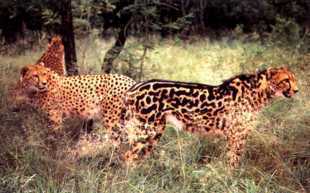
|
|
|

|

|
|
|

|
 African folklore had long described a different variety of cheetah than the one scientists were familiar with. This cheetah was a giant, and it had a totally different pattern on its coat than normal cheetahs. Like most creatures described in folklore, the king cheetah was the object of much ridicule and there were virtually no serious efforts to find out if it really existed, even though skins with the king cheetah pattern were known to exist.
African folklore had long described a different variety of cheetah than the one scientists were familiar with. This cheetah was a giant, and it had a totally different pattern on its coat than normal cheetahs. Like most creatures described in folklore, the king cheetah was the object of much ridicule and there were virtually no serious efforts to find out if it really existed, even though skins with the king cheetah pattern were known to exist.
One husband and wife team refused to give up. They collected skins which showed the unusual pattern and then embarked on an ingenious scheme to film king cheetahs by ballooning across the areas where these creatures had been sighted and attempting to prove their existence through film. Their plan worked. There were indeed cheetahs that were bigger than normal, with different patterns than normal. Today, scientists have been surprised by further discoveries. King cheetahs are not limited to a small area. They are actually found everywhere that cheetahs are found. This is because king cheetahs are genetic mutants, like color phases, not a separate species or subspecies.
Some other varieties of cheetah remain in the realm of cryptozoology, still unconfirmed by science. These beasts include the desert cheetah, sometimes called the Qattara cheetah after a location in Egypt where its tracks and sightings have received the most attention. The desert cheetah supposedly inhabits the Sahara Desert, a far different habitat than normal cheetahs, and has a pale, sand-colored coat with a different texture to it than normal cheetah pelts. If confirmed, the desert cheetah would stand a fair chance of being declared a new subspecies, since it looks different and inhabits a different habitat. The woolly cheetah is another mystery. Pelts, skulls and descriptions written by scientific observers exist in collections. In comparison to normal cheetahs, the woolly cheetah shows a woolly fur texture, a different coat pattern that has no black spots (replacing them with dark blotches), shorter legs, a heavier body build, and a larger adult size. The skulls seem identical to normal cheetah skulls.
Further mystery cheetahs are reported from remote areas in Asia where they supposedly went extinct decades ago. If confirmed, these Asian populations could be very important to cheetah survival. Normal wild cheetahs from Africa are highly inbred, and further expected reductions in their population mean only more inbreeding. Discovering a population of cheetahs that has been largely separate from African cheetahs for a long time would mean more genetic variety for the species as a whole, even if the Asian population of cheetahs was also quite inbred, because each population would have different genetic tendencies.
| You can find out more about the King Cheetah and other Mystery Cheetahs from the following sources: |
Bottriell, Lena Godsall. King Cheetah: The Story of the Quest.
Clark, Jerome and Coleman, Loren. Cryptozoology A-Z. New York: Simon & Schuster, 1999. Pages 122-123
|
Divyabhanusinh. The End of a Trail: The Cheetah in India.
Newton, Michael. Encyclopedia of Cryptozoology: A Global Guide to Hidden Animals and Their Pursuers. Jefferson, North Carolina: McFarland & Company, 2005. Pages 146, 230-231, 388, 424, 495
Wikipedia, The. King Cheetah
The text on this page is copyright 2005 by Jamie Hall. Please use proper citation if you are using this website for research.